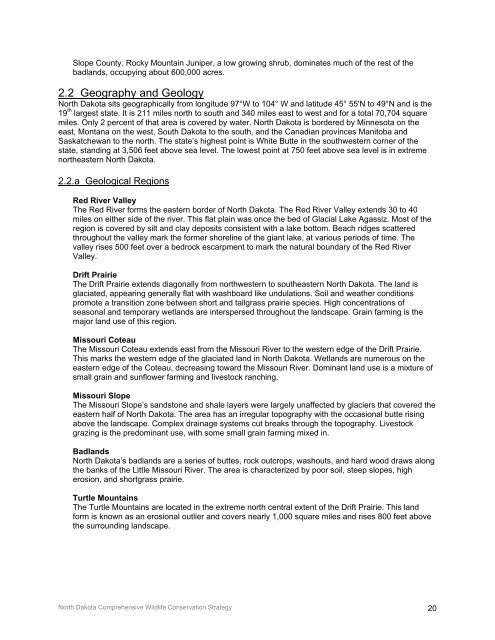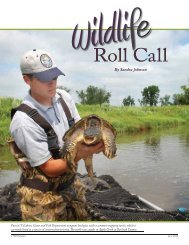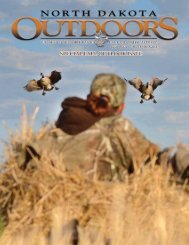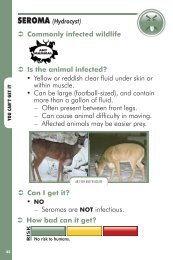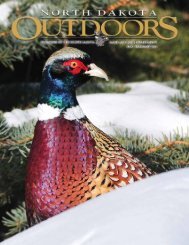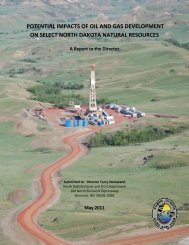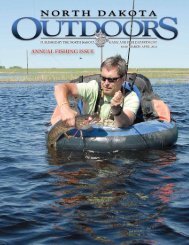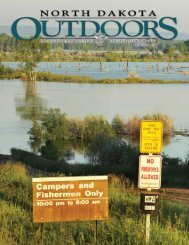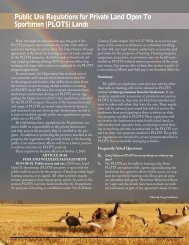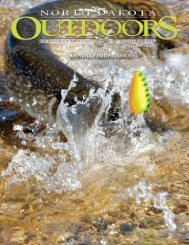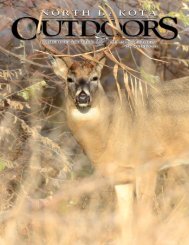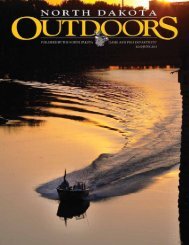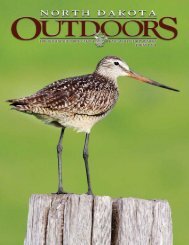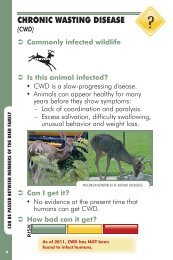- Page 1 and 2: COMPREHENSIVE WILDLIFE CONSERVATION
- Page 3 and 4: FOREWORD North Dakota Comprehensive
- Page 5 and 6: 4.2 Identifying Key Habitats and Co
- Page 7 and 8: 8.1.p North Dakota Natural Resource
- Page 9 and 10: NDSEED Sustainable Energy for Econo
- Page 11 and 12: (USFWS), Dan Svingen (USFS), Jan Sw
- Page 13 and 14: species of conservation priority of
- Page 15 and 16: Element 2: Descriptions of location
- Page 17 and 18: Element 6: Descriptions of procedur
- Page 19 and 20: 1.3 CWCS Purpose Why does North Dak
- Page 21: the Missouri Coteau and Drift Prair
- Page 25 and 26: the CWCS, the task of attempting to
- Page 27 and 28: (3) a North American Waterbird Cons
- Page 29 and 30: Table 1. North Dakota’s 100 Speci
- Page 31 and 32: Table 3. Matrix of amphibian, repti
- Page 33 and 34: Figure 2. Bird Conservation Regions
- Page 35 and 36: 17. COSEWIC.2003. COSEWIC Assessmen
- Page 37 and 38: SECTION 4 Habitat, Threats, and Con
- Page 39 and 40: • Provide information regarding i
- Page 41 and 42: In some cases there was sufficient
- Page 43 and 44: # of Farms 100,000 90,000 80,000 70
- Page 45 and 46: proposed acquisition. The advisory
- Page 47 and 48: state ownership, the highest priori
- Page 49 and 50: jumping mouse, Western jumping mous
- Page 51 and 52: TALLGRASS PRAIRIE (Red River Valley
- Page 53 and 54: Other Characteristic Wildlife: Bird
- Page 55 and 56: EASTERN MIXED-GRASS PRAIRIE (Drift
- Page 57 and 58: Other Characteristic Wildlife: Bird
- Page 59 and 60: MIXED-GRASS PRAIRIE (Missouri Cotea
- Page 61 and 62: common yellowthroat, clay-colored s
- Page 63 and 64: WESTERN MIXED-GRASS/SHORTGRASS PRAI
- Page 65 and 66: meadow jumping mouse, Western jumpi
- Page 67 and 68: 5.6 Wetlands and Lakes Area: 3,920,
- Page 69 and 70: Other Characteristic Breeding Amphi
- Page 71 and 72: CONSERVATION PROBLEM Data Gaps WETL
- Page 73 and 74:
Other Characteristic Wildlife: Bird
- Page 75 and 76:
and flows south into South Dakota.
- Page 77 and 78:
5.7.j Conservation Problems and Act
- Page 79 and 80:
5.8 Badlands Area: 1,845,000 acres
- Page 81 and 82:
5.8.c Conservation Problems and Act
- Page 83 and 84:
5.9 Upland Deciduous Forest Area: 9
- Page 85 and 86:
aspen, green ash, paper birch, West
- Page 87 and 88:
UPLAND DECIDUOUS FOREST CONSERVATIO
- Page 89 and 90:
Stewart, R. E., and H. A. Kantrud.
- Page 91 and 92:
6.2 Adaptive Management Adaptive ma
- Page 93 and 94:
to compare a suite of alternatives,
- Page 95 and 96:
o North Dakota Wetland Bioassessmen
- Page 97 and 98:
6.3.b Species Monitoring 6.3.b.i Bi
- Page 100 and 101:
6.4 Monitoring Conservation Actions
- Page 102 and 103:
SECTION 7 Reviewing the CWCS This s
- Page 104 and 105:
• Attended February 4-6, 2004 PIF
- Page 106 and 107:
8.1.k Ducks Unlimited (DU) Ducks Un
- Page 108 and 109:
management, education and administr
- Page 110 and 111:
9.3 Public Information Exchange The
- Page 112 and 113:
Message: Reptiles and Amphibians of
- Page 114 and 115:
7. North Dakota is required to matc
- Page 117 and 118:
Scientific Name: Genus species Comm
- Page 119 and 120:
This page intentionally left blank.
- Page 121 and 122:
Horned Grebe Scientific Name: Podic
- Page 123 and 124:
REFERENCES Horned Grebe Level I Bau
- Page 125 and 126:
American White Pelican Level I Othe
- Page 127 and 128:
American Bittern Scientific Name: B
- Page 129 and 130:
MONITORING PLANS American Bittern L
- Page 131 and 132:
PROBLEMS WHICH MAY AFFECT THIS SPEC
- Page 133 and 134:
Northern Pintail Level II North Ame
- Page 135 and 136:
Canvasback Level II place. Human di
- Page 137 and 138:
Redhead Scientific Name: Aythya ame
- Page 139 and 140:
Redhead Level II Terres, J. K. 1991
- Page 141 and 142:
Northern Harrier Level II Other Nat
- Page 143 and 144:
Swainson ’s Hawk Scientific Name:
- Page 145 and 146:
Swainson’s Hawk Level I will dete
- Page 147 and 148:
Ferruginous Hawk Level I conversion
- Page 149 and 150:
Ferruginous Hawk Level I Sauer, J.
- Page 151 and 152:
Golden Eagle Level II contaminants
- Page 153 and 154:
Golden Eagle Level II Rosenberg, K.
- Page 155 and 156:
Bald Eagle Level II agitate nesting
- Page 157 and 158:
Peregrine Falcon Scientific Name: F
- Page 159 and 160:
Prairie Falcon Scientific Name: Fal
- Page 161 and 162:
Prairie Falcon Level II Prairie Wil
- Page 163 and 164:
Sharp-tailed Grouse Level II Other
- Page 165 and 166:
Greater Prairie Chicken Scientific
- Page 167 and 168:
Greater Prairie Chicken Level II Ro
- Page 170 and 171:
Greater Sage-Grouse Level II Rich,
- Page 173 and 174:
REFERENCES Yellow Rail Level I Berk
- Page 175 and 176:
RESEARCH AND SURVEY EFFORTS Whoopin
- Page 177 and 178:
Piping Plover Level II nests, nest
- Page 179 and 180:
American Avocet Scientific Name: Re
- Page 181 and 182:
American Avocet Level II Research C
- Page 183 and 184:
RESEARCH AND SURVEY EFFORTS Willet
- Page 185 and 186:
Upland Sandpiper Scientific Name: B
- Page 187 and 188:
Upland Sandpiper Level I North Dako
- Page 189 and 190:
RESEARCH AND SURVEY EFFORTS Long-bi
- Page 191:
Marbled Godwit Scientific Name: Lim
- Page 194 and 195:
Wilson’s Phalarope Scientific Nam
- Page 196 and 197:
REFERENCES Wilson’s Phalarope Lev
- Page 198 and 199:
Franklin’s Gull Level I Previous
- Page 200 and 201:
Least Tern Level II nest success, d
- Page 202 and 203:
RESEARCH AND SURVEY EFFORTS Black T
- Page 204 and 205:
Black-billed Cuckoo Scientific Name
- Page 206 and 207:
Black-billed Cuckoo Level I Stewart
- Page 208 and 209:
Burrowing Owl Level II Other Natura
- Page 210 and 211:
Short-eared Owl Scientific Name: As
- Page 212 and 213:
Short-eared Owl Level II Holt, D. W
- Page 214 and 215:
RESEARCH AND SURVEY EFFORTS Red-hea
- Page 216 and 217:
Loggerhead Shrike Scientific Name:
- Page 218 and 219:
Loggerhead Shrike Level II Haas, C.
- Page 220 and 221:
RESEARCH AND SURVEY EFFORTS Sedge W
- Page 222 and 223:
Sprague’s Pipit Scientific Name:
- Page 224 and 225:
REFERENCES Sprague’s Pipit Level
- Page 226 and 227:
Brewer’s Sparrow Level III Previo
- Page 228 and 229:
Lark Bunting Scientific Name: Calam
- Page 230 and 231:
Lark Bunting Level I Kantrud, H. A.
- Page 232 and 233:
Grasshopper Sparrow Level I Other N
- Page 234 and 235:
Grasshopper Sparrow Level I Schneid
- Page 236 and 237:
Baird’s Sparrow Level I Deemed wo
- Page 238 and 239:
Le Conte’s Sparrow Scientific Nam
- Page 240 and 241:
Le Conte’s Sparrow Level II Grant
- Page 242 and 243:
RESEARCH AND SURVEY EFFORTS Nelson
- Page 244 and 245:
McCown’s Longspur Scientific Name
- Page 246 and 247:
McCown’s Longspur Level III Sible
- Page 248:
Chestnut-collared Longspur Level I
- Page 251 and 252:
RESEARCH AND SURVEY EFFORTS Dickcis
- Page 253 and 254:
Bobolink Scientific Name: Dolichony
- Page 255 and 256:
MONITORING PLANS Bobolink Level II
- Page 257 and 258:
This page intentionally left blank.
- Page 259 and 260:
Plains Spadefoot Scientific Name: S
- Page 261 and 262:
Plains Spadefoot Level I Jundt, J.
- Page 263 and 264:
Canadian Toad Level I • The REAP
- Page 265 and 266:
Common Snapping Turtle Level II •
- Page 267 and 268:
False Map Turtle Scientific Name: G
- Page 269 and 270:
Smooth Softshell Scientific Name: A
- Page 271 and 272:
Northern Sagebrush Lizard Scientifi
- Page 273 and 274:
Short-horned Lizard Scientific Name
- Page 275 and 276:
Northern Prairie Skink Scientific N
- Page 277 and 278:
Northern Redbelly Snake Scientific
- Page 279 and 280:
Western Hognose Snake Scientific Na
- Page 281 and 282:
Smooth Green Snake Scientific Name:
- Page 283 and 284:
This page intentionally left blank.
- Page 285 and 286:
Arctic shrew Scientific Name: Sorex
- Page 287 and 288:
Arctic Shrew Level III Wilson, Don
- Page 289 and 290:
Pygmy Shrew Level II Additional Res
- Page 291 and 292:
Western Small-footed Myotis Level I
- Page 293 and 294:
Long-eared Myotis Scientific Name:
- Page 295 and 296:
Long-eared Myotis Level III Natures
- Page 297 and 298:
RESEARCH AND SURVEY EFFORTS Long-le
- Page 299 and 300:
Hispid Pocket Mouse Scientific Name
- Page 301 and 302:
Hispid Pocket Mouse Level III Seabl
- Page 303 and 304:
Plains Pocket Mouse Level III • D
- Page 305 and 306:
Sagebrush Vole Scientific Name: Lem
- Page 307 and 308:
Black-tailed Prairie Dog Scientific
- Page 309 and 310:
Black-tailed Prairie Dog Level I Gr
- Page 311 and 312:
Richardson’s Ground Squirrel Leve
- Page 313 and 314:
Gray Wolf Scientific Name: Canis lu
- Page 315 and 316:
Gray Wolf Level III Ballard, W.B. a
- Page 317 and 318:
RESEARCH AND SURVEY EFFORTS Swift F
- Page 319 and 320:
River Otter Scientific Name: Lontra
- Page 321 and 322:
River Otter Level II Other Problems
- Page 323 and 324:
Black-footed Ferret Level I • A s
- Page 325 and 326:
Eastern Spotted Skunk Scientific Na
- Page 327 and 328:
Eastern Spotted Skunk Level III Sov
- Page 329 and 330:
APPENDIX A.4 Fish Species of Conser
- Page 331 and 332:
Chestnut Lamprey Level III • In t
- Page 333 and 334:
Silver Lamprey Scientific Name: Ict
- Page 335 and 336:
Silver Lamprey Level III MONITORING
- Page 337 and 338:
Pallid Sturgeon Level II impoundmen
- Page 339 and 340:
Paddlefish Scientific Name: Polyodo
- Page 341 and 342:
Paddlefish Level II MONITORING PLAN
- Page 343 and 344:
Central Stoneroller Level III • R
- Page 345 and 346:
Sturgeon Chub Scientific Name: Macr
- Page 347 and 348:
Sturgeon Chub Level I • Survey ar
- Page 349 and 350:
RESEARCH AND SURVEY EFFORTS Sicklef
- Page 351 and 352:
Silver Chub Scientific Name: Macrhy
- Page 353 and 354:
Silver Chub Level II MONITORING PLA
- Page 355 and 356:
Pearl Dace Level I Previous Researc
- Page 357 and 358:
Hornyhead Chub Scientific Name: Noc
- Page 359 and 360:
REFERENCES Hornyhead Chub Level III
- Page 361 and 362:
Pugnose Shiner Level III • In the
- Page 363 and 364:
Blacknose Shiner Scientific Name: N
- Page 365 and 366:
Blacknose Shiner Level III • The
- Page 367 and 368:
Rosyface Shiner Level III • Fish
- Page 369 and 370:
Northern Redbelly Dace Scientific N
- Page 371 and 372:
Northern Redbelly Dace Level II •
- Page 373 and 374:
Finescale Dace Level III • A simi
- Page 375 and 376:
Flathead Chub Scientific Name: Plat
- Page 377 and 378:
REFERENCES Flathead Chub Level II F
- Page 379 and 380:
Blue Sucker Level I Previous Resear
- Page 381 and 382:
Yellow Bullhead Scientific Name: Am
- Page 383 and 384:
Yellow Bullhead Level III • Ongoi
- Page 385 and 386:
Flathead Catfish Level III Addition
- Page 387 and 388:
Trout-perch Level II • In the lat
- Page 389 and 390:
Logperch Scientific Name: Percina c
- Page 391 and 392:
Logperch Level III MONITORING PLANS
- Page 393 and 394:
River Darter Level III • In the l
- Page 395 and 396:
This page intentionally left blank.
- Page 397 and 398:
Threeridge Scientific Name: Amblema
- Page 399 and 400:
Wabash Pigtoe Scientific Name: Fusc
- Page 401 and 402:
Mapleleaf Scientific Name: Quadrula
- Page 404 and 405:
Black Sandshell Level II • A smal
- Page 406 and 407:
Creek Heelsplitter Level II • A s
- Page 408 and 409:
Pink Heelsplitter Level II • The
- Page 410 and 411:
Pink Papershell Level III MONITORIN
- Page 412 and 413:
APPENDIX B Landscape Component Maps
- Page 414 and 415:
412
- Page 416 and 417:
414
- Page 418 and 419:
416
- Page 420 and 421:
418
- Page 422 and 423:
This page intentionally left blank.
- Page 424 and 425:
Note: The focus area “CRP” is n
- Page 426 and 427:
APPENDIX D Conservation Challenges
- Page 428 and 429:
426
- Page 430 and 431:
428
- Page 432 and 433:
APPENDIX E Breeding Habitat for Bir
- Page 434 and 435:
Effects of Management Practices on
- Page 436 and 437:
Effects of Management Practices on
- Page 438 and 439:
Effects of Management Practices on
- Page 440 and 441:
Effects of Management Practices on
- Page 442 and 443:
Ideal Breeding/Habitat Conditions a
- Page 444 and 445:
Seasonal (Class 3, Seasonally Flood
- Page 446 and 447:
References A Glossary of Terms Used
- Page 448 and 449:
APPENDIX F Glossary 446
- Page 450 and 451:
objectives, and evaluate multiple u
- Page 452 and 453:
L Landscape. (1) Aspects of the lan
- Page 454 and 455:
growing season, are incorporated in
- Page 456:
This page intentionally left blank.


